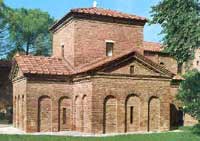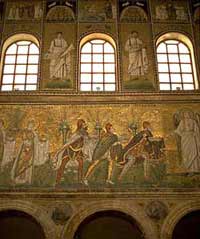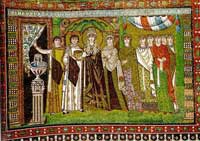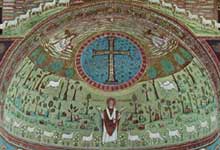Byzantine art originated in Byzantium in the IV century AD; at the time the Roman Empire was divided into two parts: the Western Empire (capital: Rome ) and the Eastern Empire (capital: Byzantium ).
In the VI century AD, after the fall of the Western Empire, the eastern emperor Justinian led his armies into Italy , to free the country from the Goths. At the time, the city of Ravenna , where the exarch resided, was an important artistic and cultural centre. The art dating from this period has a marked preference for central plan buildings (the Mausoleum of Galla Placidia, decorated with splendid mosaics, is an example).
Sculpture was not common at this time and was generally limited to architectural elements such as capitals, pulvinos, doorframes or sarcophagi.
During the Byzantine period painting techniques concentrated mainly on mosaic decorations rather than frescos. The churches of Sant'Apollinare in classe and Sant'Apollinare Nuovo, both in Ravenna , are examples of this. The subjects represented here are generally holy scenes, landscapes, animals, figures of saints set against an almost invariably golden background.
Mausoleum of Galla Placidia.
 The Mausoleum of Galla Placidiais a central plan building with a Greekcross design, covered by circular vaults resting on the four arms of the cross, with a dome at the centre. The exterior is made of plain terracotta bricks without decorations and the dome is not visible from the outside because it is covered by the tiburium.
The Mausoleum of Galla Placidiais a central plan building with a Greekcross design, covered by circular vaults resting on the four arms of the cross, with a dome at the centre. The exterior is made of plain terracotta bricks without decorations and the dome is not visible from the outside because it is covered by the tiburium.
The interior is richly decorated by mosaics and precious marble which seems to expand the architectural space.
Mausoleo degli ortodossi o Neoniano
This mausoleum (erected for the members of the Orthodox church) has an octagonal plan with apses on four sides. The exterior is made of bricks whereas the interior has three levels of overlapping decorations. The two lower levels have two series of arches standing on beautifully carved pulvinos; the arches of the middle area are decorated withstuccos and the upper part of the dome is decorated with a sumptuous mosaic showing the baptism of Christ.
Basilica of Sant'Apollinare Nuovo
 This basilica has three naves and the central one in an apse. There are three levels of mosaic decorations along the main nave: in the lower one the Palace of Theodoricus is shown, as well as processions of Holy Martyrs and Holy Virgins, with the characteristics which are typical of Oriental Art (such as frontality, bidimensionality, lack of volume and fixed gazes). The middle level is between the windows and shows figures of people, whereas the upper one is made up of small scenes.
This basilica has three naves and the central one in an apse. There are three levels of mosaic decorations along the main nave: in the lower one the Palace of Theodoricus is shown, as well as processions of Holy Martyrs and Holy Virgins, with the characteristics which are typical of Oriental Art (such as frontality, bidimensionality, lack of volume and fixed gazes). The middle level is between the windows and shows figures of people, whereas the upper one is made up of small scenes.
Mausoleum of Theodoricus
The Emperor Theodoricus had a mausoleum built entirely of stone from Istria to preserve his mortal remains. The building has an octagonal plan with a large monolithic dome on it. The style of the decorations is typically barbarian.
Church of San Vitale
 The basilica of San Vitale in Ravenna was built in 547. It has an octagonal plan and the very simple exterior is made of bricks whereas the interior is richly decorated. The most important mosaics decorating the church are the ones in the presbytery. Among them are panels showing Justinian and Theodora, accompanied by dignitaries and ladies-in-waiting. These mosaics, like the others executed in this period, have the typical bidimensionality and the figures have fixed stares. All the people portrayed are richly dressed and wear jewels.
The basilica of San Vitale in Ravenna was built in 547. It has an octagonal plan and the very simple exterior is made of bricks whereas the interior is richly decorated. The most important mosaics decorating the church are the ones in the presbytery. Among them are panels showing Justinian and Theodora, accompanied by dignitaries and ladies-in-waiting. These mosaics, like the others executed in this period, have the typical bidimensionality and the figures have fixed stares. All the people portrayed are richly dressed and wear jewels.
Basilica of Sant'Apollinare in Classe 
The style of the basilica of Sant'Apollinare in Classe is Byzantine. The mosaics of the apse basin are divided into two parts with a jewelled cross at the centre. The saint, surrounded by 12 sheep symbolising the Apostles, is in the lower area which is a garden with flowers.